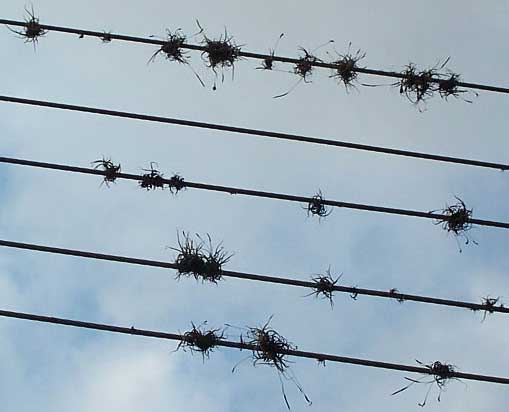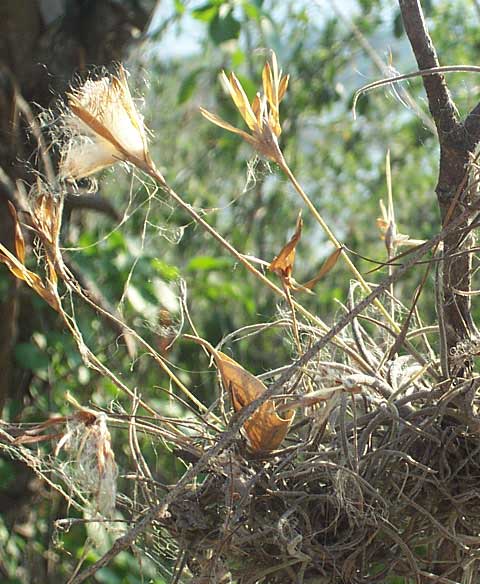Excerpts from Jim Conrad's
Naturalist Newsletter
from the January 12, 2007 Newsletter issued from Sierra Gorda Biosphere Reserve, QUERÉTARO, MÉXICO
BROMELIADS ON POWER LINES
Travellers in the tropics know very well the phenomenon shown below:

That picture is of bromeliads growing naturally on power lines here in Jalpan. The bromeliad is TILLANDSIA RECURVATA, sometimes called Small Ballmoss, though it's a bromeliad, not a moss. As you might expect with a species that can grow on power lines, this is a tough little plant with an enormous distribution throughout tropical and part of subtropical America. It's found from as far north as Georgia and Arizona south to southern South America. I've even seen it growing on cactus spines and barbed-wire fences.
Seeing Tillandsia recurvata on power lines should dispel any suspicions you might have that epiphytes -- plants growing on other plants and elevated structures -- have to be at least a little parasitic on their hosts to survive.
The vast majority of epiphytes aren't parasitic at all. They just grow epiphytically because they need a place to live and their perches give them access to light. Though the percentage is much less in temperate climates, when the whole world's seed plants and ferns are considered, about 10% of them are epiphytes. Over half of the Orchid Family's 20,000 species are epiphytic.
Whenever you read how epiphytes manage to survive you find a great deal about dust, trapped organic debris accumulating around plant bases, and trickling rainwater, but there's little said about microorganisms. Recently studies have shown that in many epiphytic species bacteria play a huge role by fixing atmospheric nitrogen. Almost all orchids have mycorrhiza associated with their roots which provide the plants with micronutrients. Our little Tillandsia recurvata has been shown to have its blade surfaces populated by the nitrogen-fixing bacterium called Pseudomonas stutzeri.
So here's more evidence that we underestimate the importance of microorganisms in our lives, and to Life on Earth. We've already spoken of how very much the health and survival of animal species -- humans being animals -- depend on a diverse, well balanced population of bacteria being present in our guts.
Sometimes I think that future generations may regard the manner in which we abuse the planet's microorganisms as even more disastrous than how we deal with global warming and nuclear proliferation. When we clear-cut a forest and cause so much erosion and oxidation of the soil's organic content, that's devastating on the established bacteria. From the regenerating forest's point of view, loss of a healthy community of bacteria may be worse than losing normal soil structure and the forest's self-regulating microclimate.
from the May 12, 2007 Newsletter issued from Sierra Gorda Biosphere Reserve, QUERÉTARO, MÉXICO
BROMELIAD FRUITS
The most abundant bromeliads in trees along the reservoir road are fruiting now, as you can see below:

That's the same species I introduced flowering in this year's April 28th Newsletter. I'm supposing it to be TILLANDSIA RECURVATA. (Latter confirmed by iNaturalist expert).
In the more recent fruiting picture, the item on a slender stem looking a little like a wad of spaghetti on a fork, at the top, left, is a fruit pod that has split open and is releasing masses of slender seeds bearing long, white hairs. The hairs catch breezes and disseminate the seeds much in manner of how dandelion and thistle seeds get blown about on their white "parachutes." In the picture you can barely make out slender, pale-brown seeds enmeshed in white fuzz.
Last month this species was very pretty with its inflorescence's bright, red bracts and yellow corollas, but now the plants are dried-up, dusty, and cobwebby. Instead of one parachuted seed at a time abandoning its pod, most typically a puff of wind jars loose a whole gob, which catches on the plant's own blades or, more commonly, in spider webs, as shown in the picture.
North America's Spanish Moss, also a member of this genus Tillandsia, produces similar hairy seeds and I've often wondered how such airborne seeds manage to land on a tree limb just right so that the seed eventually germinates and issues anchoring roots. After seeing what happens with our seeds, now I'm imagining masses of fuzz-entangled seeds catching on spider webs, rains come and the whole mess sags onto branch bark, creating a kind of microclimate-producing seed-hair/ spider-web compost capable of retaining enough moisture to help a tiny seed germinate. Maybe spider webs aren't necessary for this scenario, but from what I'm seeing they assist the compost-forming process more often than not. Maybe this is a mutualistic relationship where spiders find homes among the bromeliads, and bromeliad seeds are helped in their sprouting by the spiders' webs.
Not all members of the Bromeliad Family, the Bromeliaceae, produce dry capsules that split at maturity like ours in the picture. The family divides into two large groups, one group forming dry capsules but the other creating berries. The most famous bromeliad is the Pineapple, which produces berries. The part we eat is not that berry, though the berries with their aborted ovules are imbedded in what we eat.